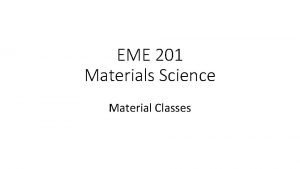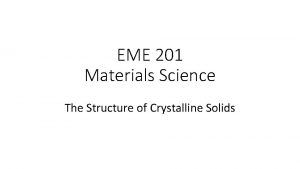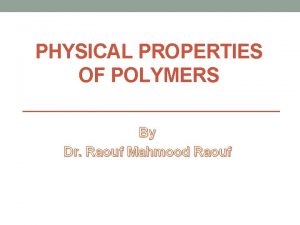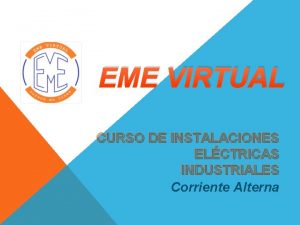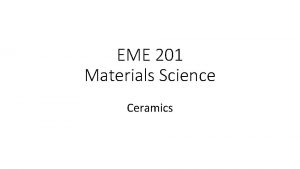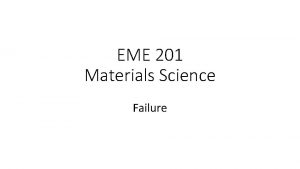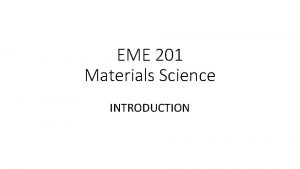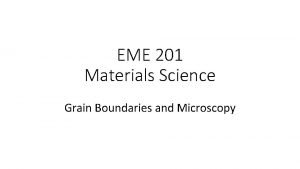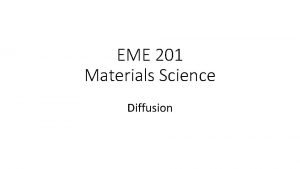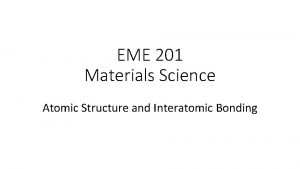EME 201 Materials Science Material Classes Polymers Polymers











- Slides: 11

EME 201 Materials Science Material Classes

Polymers • Polymers are generally organic substances prepared using a process known as polymerization. • Polymeric materials contain rubber type of elastomers and many types of adhesives. • Most of the polymeric materials have very good electrical resistivity. • Polymeric materials can also provide good thermal insulation at the same time. • Although having lower strength, the polymeric materials have a very good strength / weight ratio. • These materials are usually not suitable for use at high temperatures. • On the other hand, many polymers are very resistant to corrosive chemicals.

Polymers • The polymeric materias have thousands of commercial applications, which range from bulletproof vests, compact discs (CDs), ropes and liquid crystal displays (LCDs) to clothes and coffee cups. • The thermoplastic type of polymeric materials, where the long molecular chains are not tightly bonded, have good ductility and formability; On the other hand thermosetting type of polymeric materials are stronger but more fragile because the molecular chains are tightly linked. • The plastic materials are used in many applications including electronic devices. • Thermoplastics are made by shaping the molten form of the polymeric material. • Thermosetting type of materials are typically cast into molds.

Polymers

Semiconductors • Germanium, gallium arsenide and especially silicon based semiconductors are part of a wider class of materials known as electronic materials. • The semiconducting materials have the electricalconductivity between ceramic insulators and metal conductors. • Semiconducting materials activated the information age. • In semiconductors, conductivity level can be controlled by doping. • In many commercial applications, we need large single crystals of semiconductors, which are not easy to prepare using simple processing techniques. • Single crystal semiconductors are grown from molten substances. • Generally, thin films of semiconducting materials are also made using special processes.

Composite Materials • The basic idea behind the development of composite materials is to blend the properties of different materials. • Composite materals consist of two or more materials, producing properties not found in a single material. • Examples for the composite materials can be illustrated as concrete and fiberglass. • We can produce light, durable, ductile, high heat resistant materials with composites or we can produce hard, impact resistant cutting tools. • Advanced aircraft and spacecrafts rely heavily on compounds such as carbon fiber reinforced polymers. • Sports equipment like bicycles, golf clubs and tennis rackets also benefit from a variety of lightweight and rigid composite materials.

Functional Classification of Materials

Functional Classification of Materials Aerospace: • Aluminum alloys, polymeri materials, carbon-carbon composites, and many other materials belong to this category. Biomedical: • A number of artificial organs are made using different polymeric materials, titanium alloys, and nonmagnetic stainless steels. Electronic Materials: • Semiconductoring materials like silicon are used to make integrated circuits for computer chips. • Aluminum, and other type of metals are used as conductors in power transmission and in microelectronics.

Functional Classification of Materials Energy Technology: • Battery technology has gained significant importance due to the need for many electronic devices that require longer life and portable power. • Fuel cells, that are a kind of battery, are also being used in some cars. Magnetic Materials: • Computer accesories make use of many matellic, ceramic, and polymeric materials. • For example, computer hard disks are made using alloys based on cobaltplatinum-tantalum-chromium (Co-Pt-Ta-Cr) alloys. • Certain types of magnetic materials such as ferrites are used to make inductors and components for wireless communications.

Functional Classification of Materials Photonic or Optical Materials: • Silicon dioxide is widely used to make optical fibers. • Optical materials are utilized to prepare semiconductor type of detectors and lasers, which are used in fiber optic communications systems and other applications. Smart Materials: • A smart material can be susceptible to and respond to an external stimulus such as changes in temperature, the application of stress, or changes in humidity or the chemical environment. • Lead zirconium titanate, shape-memory alloy can be shown as examples for the smart materials.

REFERENCES • William D. Callister, ‘Materials Science and Engineering: An Introduction’, Seventh edition, John Wiley & Sons, Inc. , U. S. A. • Brian S. Mitchell, ‘AN INTRODUCTION TO MATERIALS ENGINEERING AND SCIENCE FOR CHEMICAL AND MATERIALS ENGINEERS’, John Wiley & Sons, Inc. , U. S. A, 2004. • J. W. Martin, ‘Materials for Engineering’, Third Edition, WOODHEAD PUBLISHING LIMITED, Cambridge, England. • Donald R. Askeland & Pradeep P. Fulay, ‘Essentials of Materials Science and Engineering’, Second Edition, Cengage Learning, Toronto, Canada. • G. S. Brady, H. R. Clauser, J. A. Vaccari, ‘Materials Handbook’, Fifteenth Edition, Mc. Graw-Hill Handbooks.
